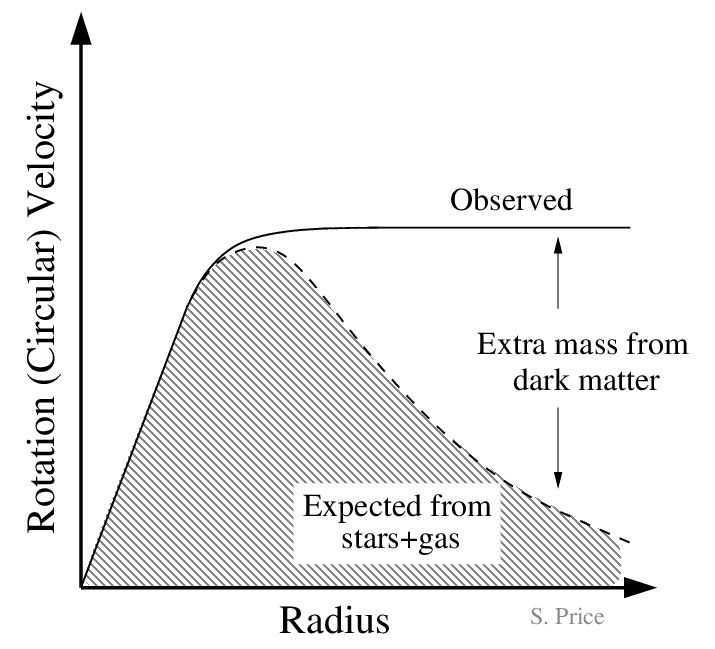Galaxy Masses
Galaxies come in many shapes, sizes, and colors. However, these properties are not random, and all seem to correlate with the total mass of a galaxy, which includes all the stars, gas, dust, and dark matter in a galaxy. For example, very massive galaxies have red colors and elliptical shapes, while less massive galaxies are primarily disks and have blue colors. The color of the light from these galaxies reflects the age of the stars, with redder colors being indicative of older stellar populations. Thus, very massive galaxies tend to have older stellar populations than less massive galaxies. Based on these correlations, astronomers consider mass to be a fundamental property of a galaxies.
Masses from Observed Light
Astronomers can determine masses of galaxies using several methods. First, we can estimate the mass of all the stars in a galaxy by adding up the total amount of starlight observed from the galaxy. However, the farther away a galaxy is, the dimmer it will be. Thus, we need the distance or redshift to convert the observed light into the amount of light emitted by the galaxy. Next, we need to translate the emitted light into mass. From detailed studies of stars in our own galaxy, we know how the mass and light for a group of stars are related. The exact ratio between mass and light depends primarily on the age and thus color of the stellar population. The color of a stellar population depends on the mix of stars within the a galaxy. Older galaxies are redder because there are higher fractions of low-mass red stars, as the high-mass blue stars are short-lived. Thus, the combination of the observed light, the distance, and the color gives us the total mass in stars.
Galaxies also contain gas, which can contribute significantly to the total mass. While the total amount of gas can be directly measured using radio telescopes, this is only possible for galaxies that are relatively close to us. For more distant galaxies (like those in the MOSDEF survey) we can use a trick to determine the gas masses. In nearby galaxies, astronomers found that the star formation or stellar birth rate correlates with the total gas mass. In turn, the stellar birth rate can be derived from the observed light from hydrogen gas illuminated by newly formed stars, as explained here. Thus, we can use the light produced by illuminated hydrogen gas to estimate the total mass in gas.
Masses from Internal Motions
It is also possible to measure the mass of a galaxy by studying the motions of the gas and stars inside it. The gravitational forces within a galaxy determine how fast the gas and stars move. Thus we can measure these motions to independently determine a galaxy’s total mass, as well as measure the distribution of the mass within that galaxy.
In disk galaxies, stars and gas generally rotate around the center of the galaxy, where their rotation speed changes with distance away from the center (radius) depending on the mass of the galaxy and how the mass is distributed.
Evidence for Dark Matter

Based on the measurements of the masses of the stars and gas in the galaxies, the rotation profile should follow the dashed line in Figure 1, with the profile rising and then decreasing towards the edges of the galaxy. However, very detailed measurements of the orbital speeds of nearby galaxies were made in the 1970’s (including pioneering work by Vera Rubin), and resulted in an unexpected finding. The observations showed that the rotation velocity rose and then remained constant, even beyond the visual extent of the galaxy (solid line in Figure 1). If gravity behaves like we observe it here on Earth (and other observations suggest this to be true), then there must be more mass in the outskirts of galaxies than just the stars and gas. This difference between the observed and expected rotation curve of spiral galaxies provided the first evidence for dark matter.
Dark Matter in MOSDEF Galaxies
Using the MOSDEF survey, we derived the total masses of our distant galaxies using both the galaxy’s total light as well as the internal motions of the gas and stars. Similar to results for nearby disk galaxies discussed above, we found that the motions of the gas resulted in a larger mass measurement than the mass derived from the observed light, and thus dark matter is present in these distant galaxies as well. The amount of dark matter in the MOSDEF galaxies is about 10% of the total mass within the galaxy. This value is similar to values for nearby galaxies. As illustrated in Figure 1, the amount of dark matter is relatively small near the center and increases further away from the galaxy center. If we were able to trace the motions of gas out to larger distances in the galaxies of the MOSDEF survey, we would likely see that dark matter makes up larger fractions of the total mass of the galaxies, similar to what is seen in nearby galaxies.
The Growth of Disk Galaxies
We combined the observations of the gas motions with measurements of the galaxy shapes or morphologies to learn about the internal properties of the galaxies in the MOSDEF survey. Interestingly, the gas motions in distant galaxies are less ordered than in nearby disk galaxies, and galaxy disks were much thicker and smaller when the Universe was only a fraction of its current age. With the full MOSDEF survey we will examine how these distant small and irregular galaxies evolved into the orderly spiral or elliptical galaxies in the nearby Universe.